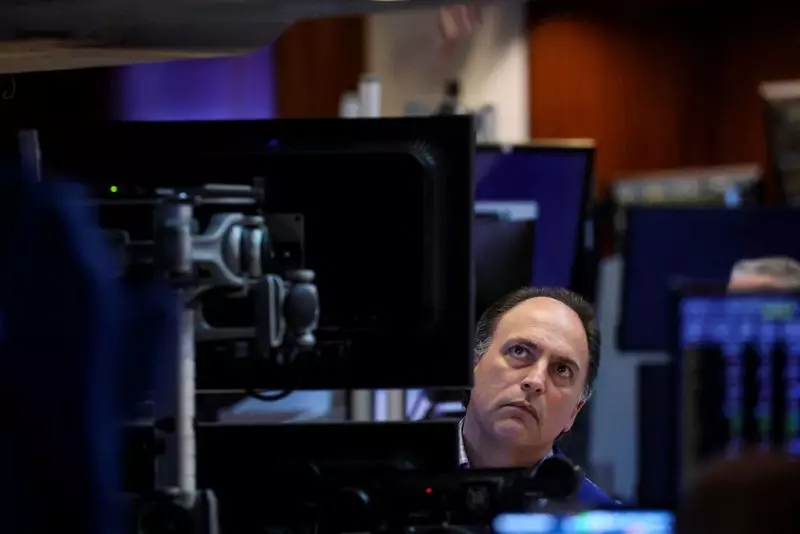As the U.S. stock market opens the week, a palpable tension hangs over traders and investors alike. With presidential elections on the horizon and an impending Federal Reserve meeting, market movements are reflecting this uncertainty. At the onset of trading on Monday, major indices observed slight declines: the Dow Jones Industrial Average saw a drop of 45 points (0.1%), the S&P 500 fell by 3 points (0.1%), and the NASDAQ Composite decreased by 55 points (0.3%). This unease among investors is primarily due to the highly competitive nature of the upcoming presidential elections, where polls suggest a close contest between Donald Trump and Kamala Harris.
The fluctuation in the dollar’s value and rising Treasury yields indicate that numerous investors are positioning themselves in anticipation of a Trump victory. Such an outcome is anticipated to usher in more inflationary policies, a prospect that naturally influences market behavior. Analysts from Wedbush provided insights on how elections intertwine with market performance, particularly emphasizing concerns surrounding the tech sector in the event of a Trump win. The potential for heightened U.S.-China tensions and escalated tariffs looms large, prompting global tech investors to reassess their positions.
The ramifications of the elections could be especially pronounced for technology companies. Analysts caution that a significant shift in tariff policies and a more aggressive approach towards China might adversely affect the supply chain dynamics for companies like Nvidia and Apple. In their analysis, Wedbush experts highlighted the potential for retaliatory actions from Beijing, which could slow the pace of technological advancements in the industry. This apprehension suggests that irrespective of the election result, the delicate balance of global trade relations might significantly impact the U.S. technology landscape, highlighting the interconnectedness of politics and economics.
In tandem with the political landscape, the current earnings season is underway. This week, around 20% of S&P 500 companies are scheduled to release their earnings reports, which may provide further insights into market outlooks. Notably, the hospitality sector is feeling the pressure, as Marriott International shares dipped by 2.7% after the chain lowered its profit forecasts due to ongoing weak travel demand both domestically and in key markets like China. This represents a broader trend where economic uncertainties continue to affect sectors reliant on consumer activity.
Conversely, biotech firms seem to capture investor interest, with Viking Therapeutics stock surging by 5.4% after it published favorable results from its recent Phase 1 trial for its oral weight-loss drug. This highlights the diverse reactions that different sectors display in response to market conditions, reinforcing the notion that not all industries are uniformly affected by evolving economic situations.
This week’s Federal Reserve meeting stands as a crucial event for market watchers. Preliminary expectations suggest a 25 basis points interest rate cut after a more aggressive 50 basis points reduction in September. However, economic data has recently indicated resilience in the U.S. economy, alongside persistent inflationary pressures, which could restrain the Fed from committing to a defined trajectory of future rate cuts. Fed Chair Jerome Powell’s strategy emphasizes a data-driven approach, making it likely he avoids predicting ongoing monetary easing, thus adding another layer of speculation for investors.
Additionally, recent employment data showed a notable slowdown in job growth for October, signifying potential cooling in the labor market. Such indicators further complicate the Fed’s decision-making processes as they strive to navigate balancing economic stimulation with inflation control.
In global commodities, oil prices experienced a welcome rally as OPEC+ announced the postponement of a planned crude output increase. The Brent crude contract rose by 2.5% to approximately $74.92 per barrel, while U.S. crude futures gained 2.8%, reaching around $71.40 per barrel. This extension of output cuts by OPEC+ underlines concerns related to global demand, especially considering prior reports of sluggish growth. The dual factors of rising oil production in the U.S. and lingering uncertainties regarding economic recovery globally are contributing to a complex landscape for oil traders.
Overall, as the week progresses, the intertwining influences of political decisions, economic data releases, and international agreements will continue to shape market dynamics, inviting scrutiny and strategizing from investors across sectors.

